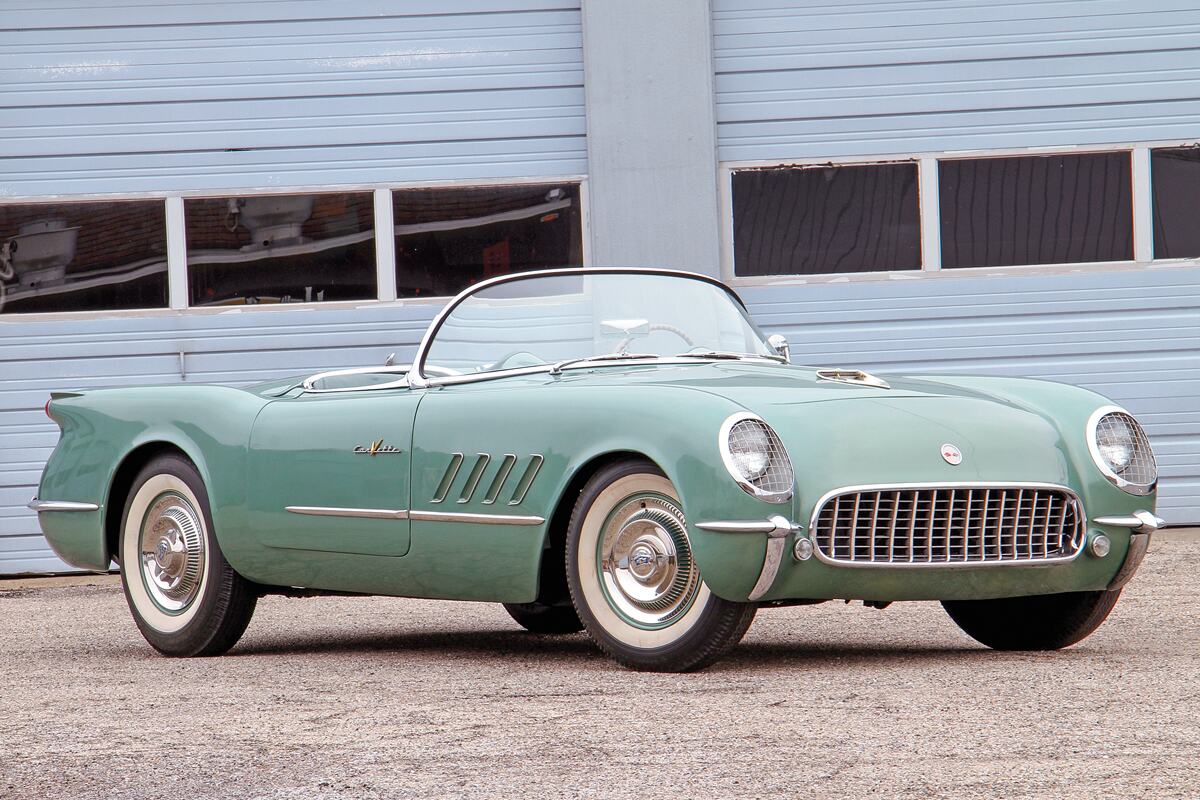By all rights and accounts this distinctive 1954 Corvette should have been flattened and shredded seven decades ago. But here it is, a restored, surviving piece of design history known simply by its internal designation, S.O. 2151.
Of course, the Corvette’s history is filled with one-offs and special builds. A great many have been lost to time, while other well-known surviving examples have become canonical to the car’s rich history. The story of S.O. 2151 is perhaps less well-known, but this very early C1 served time as a Motorama show car before being reconfigured as a design proposal for the 1955 model year.
In fact, its back-story begins with the initial stages of Corvette history. Prior to the car’s start of production on June 30, 1953, Chevrolet produced approximately 15 hand-laid fiberglass bodies intended for internal use. That would include testing and experimental projects, as well as vehicles intended for the Motorama, General Motors’ traveling cavalcade of dream cars that crisscrossed America between 1949 and ’61.

What little original photography exists confirms the accuracy of Jay’s restoration. In keeping with the design ethos of the era, the side “vents” were only for show.
Most of the Motorama vehicles didn’t carry conventional identification numbers and were instead commonly referred to by internal Special Order numbers. For the 1954 Motoroma, the Corvair fastback was S.O. 2071, the Nomad was S.O. 1954, and so on. After their time on the show circuit, these dream cars were mostly destroyed, although some were repurposed. This car’s body originally carried the number S.O. 2000.
According to owner Billy Jay and other historical accounts, the car was one of two pale-yellow show vehicles that debuted in early 1953. It is believed to have been retired early from the circuit so that its body could be returned in early 1954 to GM’s Art and Color Section for reassignment. That’s when the car was redesignated S.O. 2151 and used as a design model showcasing proposed styling updates for the 1955 Corvette.
Those updates included an egg-crate–style Bel Air grille, similar to what debuted on the redesigned 1955 Chevrolet full-size passenger cars and second-series pickups, along with a simulated hood scoop and a raised area on the trunk lid that housed the license plate (like the ’54 Corvair fastback). Additionally, canted, simulated side vents and revised trim were affixed to the body sides.

Notably, the vents and side trim differed on the car’s two sides, offering alternate ideas for the updates. They included varying placements of the Corvette script badge, which included the prominent gold “V” as the signifier for the coming V-8 engine. Because of the vents’ placement on the front fenders, the Corvette badges were moved to the doors. On the passenger side the badge was placed on the upper half of the door, and on the driver’s side it was located lower, just above the body-side molding.
“It’s a fascinating look at how one styling model displayed two design ideas,” says Jay. “That’s what made this car different from show vehicles. It was intended only for internal evaluation.”
In addition to the styling updates, S.O. 2151 was repainted Bermuda Green, the same color as the ’55 Biscayne show car (also known as the XP-37). The revamped body was then dropped on a ’54 Corvette chassis (#E54S002092) that had been fitted with a prototype six-cylinder engine equipped with a solid-lifter camshaft. A tag riveted to the right-rear corner of the engine compartment shows the car’s completion date was July 30, 1954, but photos of the car in the studio are dated as early as March of that year.

Of course, none of S.O. 2151’s proposed design updates were adopted, apart from the big-V script badge, which ended up in the same position on the front fenders as the 1953 and ’54 models. That’s because the Corvette didn’t exactly sprint out of the gate when new. After an initial run of 300 for its inaugural year, production increased to 3,640 for 1954, but dealers had a tough time moving them. Many cars were still looking for homes by the end of the year.
Frankly, it was a miracle the Corvette survived 1955—and it probably wouldn’t have if it weren’t for the unexpected success of the Ford Thunderbird. It nevertheless soldiered on, with a more significant exterior redesign in 1956. Ironically, the ’56 Corvette incorporated cues from the Biscayne show car, but S.O. 2151’s styling elements were left by the wayside.
Because of its use as a design proposal, S.O. 2151 never hit the show circuit, and by all rights it should have been crushed shortly after it rolled out of the studio. For unknown reasons it escaped a date with the executioner, but more than that, it also found its way to California. Perhaps it was shipped out there by styling czar Harley Earl or another executive for personal use, but the reason remains unknown.

Regardless, by 1963 it ended up at a San Jose dealership called Auto Center. The car’s next decade is also a mystery, but according to Jay, Chevy dealer and Corvette collector Richard Oldham purchased it in a reported “basket case” condition. Most of the Bermuda Green paintwork had been stripped off, along with all the unique trim elements that were part of the design proposal, but the original powertrain, driveline, and even the riveted S.O. 2151 ID tag in the engine compartment remained.
In 1975 Oldham advertised the project car in Hemmings Motor News, with a princely asking price of $3,000. It sold to a gentleman named George F. Campbell, who reportedly purchased it on the advice of friend and noted Corvette historian Noland Adams. The car would sit, un-restored, for the next four decades, as Campbell acquired parts and researched its history. He passed away before the restoration started, but not before it went to Jay for the intended resto.
The details are a bit complicated, but ownership of the vehicle was transferred to Jay, an Indiana-based specialist who’d restored 15 cars for the Indianapolis Motor Speedway Museum and other significant, one-off vehicles.

“S.O. 2151 was the biggest challenge of a career dating back to the ’70s,” he says. “I feel privileged to have been involved with such a significant surviving piece of the Corvette’s history, but I’d never tackled anything like it.”
The restoration consumed the better part of five years, with much of the time invested in the body. “It was in terrible condition,” says Jay. “It was cracked everywhere, and restoring it meant largely redoing all the fiberglass.”
Despite the wretched outward condition, there were still signs of the Bermuda Green paintwork, as well as the pale yellow of the car’s original Motorama guise. In fact, Jay left some a few areas of the car untouched, including the steering column and the area behind the seats, to show off the vestiges of the early paint jobs. Likewise, the trunk was left essentially un-restored, showing the original layers of paint.

Additionally, the restoration revealed telltales of the Corvette’s handmade, experimental body construction, including undeniably crude hand-laid fiberglass that was pieced together for structural function rather than production-level form. The body also has a one-piece structure and custom brass trunk hinges. And despite the car’s advanced state of decay when Richard Oldham purchased it in 1974, the powertrain and driveline had remained remarkably original.
“The rolling chassis was rusted, but intact and complete down to the original shock absorbers, brake shoes, and even the tires,” says Jay. “Also, the experimental engine block as well as all the engine components were numbered with the appropriate early-1954 date codes. It was amazing to see that.”
Even more astounding were the engine block’s cylinder walls, which still showed the crosshatch pattern from the original machining. The car’s mileage was always unknown, but evidence from the engine, brakes, and more suggested it had been driven very little, making its sorry state in the ’70s all the more perplexing.

All the parts were retained during the restoration, and the car even sits on those original 1954 tires, which still hold air (with the assistance of tubes). And while also preserving a few areas showing the remnants of the original paintwork, Jay also consciously avoided over-restoring the car in some obvious areas. The doors aren’t quite flush with the body, for example, and all of the uneven fiberglass areas under the hood were left in their original, coarse condition.
“The goal with the restoration was to be as authentic as possible to the car’s 1954 appearance, including the imperfections,” he says. “They reveal as much about the car’s history as the special design features.”
As a true one-off, the restoration of S.O. 2151 can only be judged against the photographic evidence of its original configuration, and based on the handful of black-and-white photos that exist, it appears Jay has done an admiral job. The judges at the Amelia Island Concours d’Elegance also thought so, and awarded the car the prestigious Founders Award in 2023.
“It’s been very rewarding to be involved with this very unique piece of Corvette history,” says Jay. “It never should have survived, but it did, and the mystery of that and its years in California only make its story all the more compelling.”
Indeed it does, as this is a Corvette that shouldn’t exist. With thanks to its previous caretakers and Billy Jay’s restoration, it remains a vibrant and vital historical artifact.





